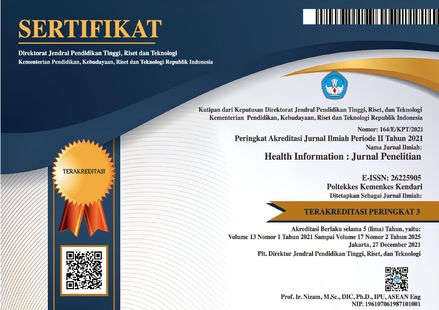Effectiveness of the Combination of Katuk Leaves (Sauropus Androgynus L.Merr) and Soy Milk on Breast Milk Production with Baby Weight Indicators
DOI:
https://doi.org/10.36990/hijp.v16i2.1177Keywords:
Effervescent, katuk leaves, Soy milk, Milk productionAbstract
In the process of exclusive breastfeeding, there are obstacles experienced by mothers that are the cause of failure in breastfeeding, one of which is caused by the mother's low milk production. Efforts are made to increase breast milk production in a non-pharmacological way. This study aims to analyze the effectiveness of effervescent tablets combined with katuk leaf (Sauropus Androgynus L. Merr) and soy milk on breast milk production in breastfeeding mothers with infant weight indicators. The method in this study is a Quasy experiment with pretest and posttest control group design. Sampling by Purposive Sampling. The number of samples was 68 normal postpartum mothers on days 1-10. Data analysis used the Repetaed Measures Anova, One Way Anova and Kruskal Wallis Test. Based on the results of the statistical test, a significance value (p=0.000) < 0.05 was obtained, which means that there was a difference in the average weight of babies in the intervention group given effervescent tablets
References
Ene, S.K., Hadi, S.P.I. and Kusumawardani, L.A. (2022) ‘Pengaruh Terapi Akupresur terhadap Peningkatan Produksi Asi pada Ibu Post Partum: Systematic Literature Review’, Malahayati Nursing Journal, 4(8), pp. 2070–2087. doi:10.33024/mnj.v4i8.6425.
Gandi, P.I. and Rahayu, S. (2024) ‘Tablet Effervescent Daun Kelor Sebagai Alternatif Peningkatan Produksi ASI Dengan Indikator Frekuensi Buang Air Besar Bayi Pada Ibu Menyusui Effervescent Tablets as an Alternative to Increase Breast Milk Production with an Indicator of Baby ’ s Defecation Frequency in Breastfeeding Mothers’, 16(1).
Handayani, H. et al. (2022) ‘Konsumsi Kedelai, Kurma, Dan Daun Katuk Untuk Meningkatkan Produksi Asi Pada Ibu Menyusui’, Midwifery Care Journal, 3(2), pp. 66–72. doi:10.31983/micajo.v3i2.8154.
Handayani, S. et al. (2022) ‘Upaya Peningkatan Pengetahuan Ibu Hamil Tentang Pemanfaatan Tanaman Lokal Sebagai Pelancar Asi’, 2(1), pp. 142–147. doi:https://doi.org/10.57267/lentera.v2i1.167.
Hardiani, R.S. (2017) ‘Status Paritas dan Pekerjaan Ibu Terhadap Pengeluaran ASI Pada Ibu Menyusui 0-6 bulan’, Nurseline Journal, Vol.2 No.1(Mei 2017), pp. 44–51. doi:https://doi.org/10.19184/nlj.v2i1.5177.
Kemenkes (2019) ‘Kementerian Kesehatan Republik Indonesia’, Kementerian Kesehatan RI, 1(1), p. 1. Available at: https://www.kemkes.go.id/article/view/19093000001/penyakit-jantung-penyebab-kematian-terbanyak-ke-2-di-indonesia.html.
Khasanah, U., Anwar, C. and Fatmasari, D. (2021) ‘Efektivitas Suplementasi Nanopartikel dari Daun Pepaya ( Carica pepaya L ) meningkatkan Berat Bayi’, 6, pp. 795–797.
Khoiriah annisa (2018) ‘Faktor-Faktor Yang Berpengaruh Terhadap Pemberian Asi Eksklusif Pada Bayi Berumur Dibawah 6 Bulan Di BPMRusmiati Okta Palembang’. doi:https://doi.org/10.36729/jam.v2i1.592.
Marliandiani Y dan NP (2015) Buku Ajar Asuhan Kebidanan Pada Masa Nifas Dan Menyusui. Jakarta: Salemba Medika.
Polwandari, F. and Wulandari, S. (2021) ‘Gambaran Usia, Paritas, Tingkat Pendidikan, Status Pekerjaan, Dukungan Suami dan Tingkat Pengetahuan Ibu dalam Pemberian ASI Eksklusif’, Faletehan Health Journal, 8(01), pp. 58–64. doi:10.33746/fhj.v8i01.236.
‘Profil Kesehatan Provinsi Nusa Tenggara Barat Tahun 2021’ (2021), 3(April), pp. 49–58.
Proverawati, A. and Rahmawati, E. (2017) Kapita Selekta ASI & Menyusui. II. Yogyakarta: Nuha Medika.
Purwoko, Bambang Ari, O.H. and Herlina (no date) ‘Gambaran Masalah Pemberian ASI Pada Ibu di Wilayah Kerja Puskesmas Palmatak’, Jurnal Online Mahasiswa (JOM), Vol. 7 No., pp. 96–103.
Puspitasari, E. (2018) ‘Pengaruh Pemberian Susu Kedelai Terhadap Peningkatan Produksi Asi Pada Ibu Nifas Di Rb Bina Sehat Bantul’, Jurnal Kebidanan, 7(1), p. 54. doi:10.26714/jk.7.1.2018.54-60.
Rahmanisa, S. and Aulianova, T. (2016) ‘Efektivitas Ekstraksi Alkaloid dan Sterol Daun Katuk (Sauropus androgynus) terhadap Produksi ASI Effectivity of Alkaloid and Sterol Extract from Katuk Leaves (Sauropus androgynus)To Breastfeeding Production’, Sauropus androgynus) terhadap Produksi ASI Majority |, 5, p. 117.
Rochsitasari, N., Santosa, B. and Puruhita, N. (2016) ‘Perbedaan Frekuensi Defekasi dan Konsistensi Tinja Bayi Sehat Usia 0–4 Bulan yang Mendapat Asi Eksklusif, Non Eksklusif, dan Susu Formula’, Jurnal Sari Pediatri, 13(3), p. 191. doi:10.14238/sp13.3.2011.191-9.
Rosdianah, R. and S, I. (2021) ‘Pemberian Ekstrak Daun Katuk Terhadap Kelancaran Asi Pada Ibu Menyusui’, Jurnal Kebidanan Malahayati, 7(2), pp. 265–273. doi:10.33024/jkm.v7i2.3585.
Safitri, Elvina, R. et al. (2021) ‘Abstract Giving Katuk Leaf Extract Can Increase Breast Milk Production in’, 7(4), pp. 751–756.
Sharma, I. and Khadka, A. (2019) ‘Assessing the level of knowledge and practice of breastfeeding among factory working mothers in Kathmandu, Nepal’, Journal of Health Research, 33(1), pp. 24–34. doi:10.1108/JHR-12-2018-0166.
Situmorang, T.S. (2019) ‘Pengaruh Konsumsi Air Rebusan Daun Katuk Terhadap Pengeluaran Produksi Asi Pada Ibu Nifas Di Bidan Praktek Mandiri Manurung Medan Tahun 2018’, Indonesian Trust Health Journal, 1(2), pp. 55–60. doi:10.37104/ithj.v1i2.13.
Sugiyono, P.D. (2015) Metode Penelitian Kuantitatif Kualitatif Dan R&D. 22nd edn. Bandung: Alfabeta.
TA?CI, K. (2013) ‘Faktor-faktor yang Berpengaruh Dengan Kecukupan ASI Pada Bayi Di Puskesmas Pahandut 1)Ketut Resmaniasih’, Angewandte Chemie International Edition, 6(11), 951–952., 2(2), pp. 1–20.
Downloads
Published
How to Cite
Issue
Section
Citation Check
License
Copyright (c) 2024 Siti Mujahida Zain, Ta’adi Ta’adi, Endah Aryati Eko Ningtyas (Author)

This work is licensed under a Creative Commons Attribution-ShareAlike 4.0 International License.
Authors retain copyright and grant the journal right of first publication with the work simultaneously licensed under a Creative Commons Attribution-ShareAlike 4.0 International License that allows others to share the work with an acknowledgment of the works authorship and initial publication in this journal and able to enter into separate, additional contractual arrangements for the non-exclusive distribution of the journals published version of the work (e.g., post it to an institutional repository or publish it in a book).
















